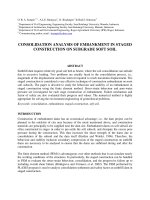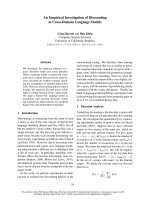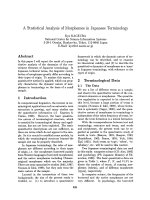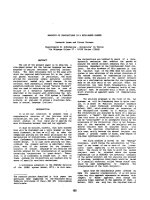analysis of segregation in cross between wild soybean (glycine soja) and cultivated soybean (glycine max) based on morphology, agronomic traits and ssr marker
Bạn đang xem bản rút gọn của tài liệu. Xem và tải ngay bản đầy đủ của tài liệu tại đây (1.49 MB, 28 trang )
MINISTRY OF EDUCATION & TRAINING
CAN THO UNIVERSITY
BIOTECHNOLOGY RESEARCH & DEVELOPMENT INSTITUTE
SUMMARY
BACHELOR OF SCIENCE THESIS
THE ADVANCED PROGRAM IN BIOTECHNOLOGY
ANALYSIS OF SEGREGATION IN CROSS
BETWEEN WILD SOYBEAN (Glycine soja) AND
CULTIVATED SOYBEAN (Glycine max) BASED
ON MORPHOLOGY, AGRONOMIC TRAITS
AND SSR MARKER
SUPERVISORS
STUDENT
Dr. TRUONG TRONG NGON
NGUYEN QUANG DAT
MSc. NGUYEN TRI YEN CHI
Student code: 3082585
Session: 34 (2008-2013)
Can Tho, 2013
MINISTRY OF EDUCATION & TRAINING
CAN THO UNIVERSITY
BIOTECHNOLOGY RESEARCH & DEVELOPMENT INSTITUTE
SUMMARY
BACHELOR OF SCIENCE THESIS
THE ADVANCED PROGRAM IN BIOTECHNOLOGY
ANALYSIS OF SEGREGATION IN CROSS
BETWEEN WILD SOYBEAN (Glycine soja) AND
CULTIVATED SOYBEAN (Glycine max) BASED
ON MORPHOLOGY, AGRONOMIC TRAITS
AND SSR MARKER
SUPERVISORS
STUDENT
Dr. TRUONG TRONG NGON
NGUYEN QUANG DAT
MSc. NGUYEN TRI YEN CHI
Student code: 3082585
Session: 34 (2008-2013)
Can Tho, 2013
APPROVAL
SUPERVISOR
STUDENT
Dr. TRUONG TRONG NGON
Can Tho, June,
NGUYEN QUANG DAT
, 2013
PRESIDENT OF EXAMINATION COMMITTEE
Abstract
F2 population made by cross between wild soybean and
cultivated soybean was analyzed for the segregation of phenotype
and genotype based on morphological characters, agronomic
characters and SSR marker. The cross was generated before
between the female parent Xanh Ha Bac (Glycine max) and the
male parent Soja 182 (Glycine soja). The results showed that the
segregation of pod color fitted to (1:2:1) ratio. The hilum color
segregated in (3:1) ratio. Four characters showed high
heritability including days to flowering (R1), plant height at (R1),
plant height at (R8), and number of nodes in main stem. The
population was divided into three groups, they were determinate,
indeterminate and semi-indeterminate. There was diversity
among these groups for plant height and number of nodes in main
stem. All of six SSR loci showed the segregation ratio of (1:2:1) in
F2 population. No segregation distortion was recorded among
these SSR loci.
Key words: wild soybean, SSR marker, segregation.
i
Content
Abstract ......................................................................................i
Content ..................................................................................... ii
1. Introduction .........................................................................1
2. Materials and methods........................................................2
2.1. Materials.........................................................................2
2.2. Methods ..........................................................................2
2.2.1. Experiment design ....................................................2
2.2.2. Phenotypic characters score......................................2
2.2.3. Genotypic analysis....................................................3
2.2.3.1. DNA extraction......................................................3
2.2.3.2. PCR amplification..................................................3
2.2.3.3. Analysis of PCR products......................................5
2.2.4. Statistics analysis......................................................5
2.2.4.1. Analysis of morphological characters....................5
2.2.4.2. Analysis of agronomic characters..........................5
2.2.4.3. Heritability of characters........................................5
3. Results and discussion.........................................................6
3.1. Inheritance of morphological traits..............................6
3.1.1. Hypocotyl color, flower color, number of leaflets,
and leaflet shape .......................................................6
3.1.2. Pod color ...................................................................8
3.1.3. Seed coat color..........................................................9
3.1.4. Hilum color .............................................................10
3.2. Stem types..................................................................10
3.3. Heritability of agronomic characters .........................10
3.4. Inheritance of growing characters..............................11
3.5. Genotypic inheritance ................................................14
ii
4. Conclusions and suggestions..............................................21
4.1. Conclusions ..................................................................21
4.2. Suggestions...................................................................21
References ..............................................................................22
iii
1. Introduction
The soybean (Glycine max) is one of important crops
around the world. This species of legume provides many products
for many uses such as foods for human and breeding, materials in
industries, improving soil.
In Vietnam, soybean has been cultivating for thousands
years. Because of the importance of soybean in country
agricultural economy, the improvement of soybean varieties is a
necessary requirement.
Wild soybean, Glycine soja, has several useful traits such
as pest resistance and drought tolerant. Conversely, cultivated
soybean rarely contain these abilities. Therefore, transferring
these traits of wild soybeans into cultivated soybeans will open
possibility to make new varieties that meet the cultivation need.
The introduction of wild soybean germplasm into
cultivated soybean seems to be a promising method to create a
new subject of soybean breeding.
To serve breeding better, scientists need to know more
clearly the segregation mode of F2 population. However, there are
few complete researches on this area up to now.
Objective: the aim of this study is to analyze the inheritance
mode of the several agronomic characters and six loci SSR in the
early segregating generation from the cross between wild soybean
and cultivated soybean.
1
2. Materials and methods
2.1. Materials
+ Xanh Ha Bac cultivar (Glycine max, landrace)
+ Accession Soja 182 (Glycine soja, Korea origin)
+ F2 population of the cross between Xanh Ha Bac (as
female parent) and Soja 182 (as male parent)
+ Chemicals and equipments for planting, DNA extraction,
PCR, and electrophoresis.
2.2. Methods
The experiments were carried out in the Molecular Biology
Laboratory and the greenhouse of Biotechnology Research &
Development Institute from September of 2012 to March of 2013.
2.2.1. Experiment design
The experiments were designed following a completely
randomized design with three replications. Each replication
consisted of one plot of Xanh Ha Bac, one plot of Soja 182 and
four plot of F2 generation.
2.2.2. Phenotypic characters score
Morphological characters including hypocotyls color,
leaflet number, leaflet shape, stem type, flower color, pod color,
seed color, and hilum color were scored.
Agronomic characters such as days to first flowering (R1),
plant height at (R1), plant height at (R8), node number in main
stem, pod number, branch number, etc. were also scored.
Standard for scoring was based on Characterization Record
Sheet of Asian Vegetable Research and Development Center.
2
2.2.3. Genotypic analysis
2.2.3.1. DNA extraction
DNA was extracted from young leaves of parents, F1, and
13 F2 plants according to CTAB protocol (Rogers and Bendich,
1988).
DNA quality were tested by electrophoresis on agarose
0,8% gel. Good DNA samples were used for PCR analysis.
2.2.3.2. PCR amplification
PCR was conducted with six SSR primers (Table 1).
Table 1. List of SSR primers
Locus
Satt
173
Satt
243
Satt
231
Satt
197
Satt
495
Satt
373
LG
Core
motif
O
(ATT)18
O
(ATT)17
E
(ATT)32
B1
(ATT)20
L
(ATT)11
L
(ATT)21
5’ to 3’
TGCGCCATTTATTCTTCA
AAGCGAAATCACCTCCTCT
GCGCATTGCACATTAGGTTTTCTGTT
GCGGTAAGATCACGCCATTATTTAAGA
GCGTGTGCAAAATGTTCATCATCT
GGCACGAATCAACATCAAAACTTC
CACTGCTTTTTCCCCTCTCT
AAGATACCCCCAACATTATTTGTAA
TGCCGCGAGATTAATATAATTTGT
GTGCGGCAAGAAGTTGAAATAAAG
TCCGCGAGATAAATTCGTAAAAT
GGCCAGATACCCAAGTTGTACTTGT
LG: linkage group
Source: />
3
The components of each reaction and the PCR cycle was
shown in Table 2 and Figure 1.
Table 2. The reaction components of PCR
Components
Buffer
(including MgCl2
10mM)
dNTP
Forward primer
Revert primer
Taq polymerase
DNA
BiH2O
o
95 C
2’
A reaction volume
(25 µl)
Concentration
1X
2.5 µl
100 µM
1 pmol
1 pmol
2.5U/µl
50 – 100 ng/µl
0.25 µl
0.25 µl
0,25 µl
0.25 µl
1 µl
20 µl
o
92 C
o
1’
68 C
Ta
1’
o
72 C
5’
1’
o
4C
∞
35 cycles
Figure 1. PCR program
(Soybase; Wang et al., 2010)
Annealing temperature (Ta) was specifically set for each
primer (from 47oC to 60oC).
4
2.2.3.3. Analysis of PCR products
10µl of each PCR product was mixed with 4µl of loading
buffer and subjected to electrophoresis on 3% agarose.
Electrophoresis was conducted at 40V in the 23cm tank that
contents TBE 1X.
SSR bands were detected by Bio-Rad XRS.
2.2.4. Statistics analysis
2.2.4.1. Analysis of morphological characters
Chi-square test was used to compute the fitness of
segregation of morphological characters to the Mendel ratio (3:1
or 1:2:1). The characters including pod color, seed coat color, and
hilum color.
2.2.4.2. Analysis of agronomic characters
Frequency distribution of three characters (days to
flowering (R1), plant height at (R1), and plan height at (R8)) was
made.
ANOVA were used to analyze parameters for almost
characters.
2.2.4.3. Heritability of characters
The heritability values in broad sense were estimated by the
following formula:
Genetic variance (VG) = VF2 – ½(VP1 + VP2)
Heritability (h2) = VG / VF2
Where VF2 is phenotypic variance in F2 population, VP1 and
VP2 are phenotypic variance in P1 (male parent) and P2 (female
parent) populations, respectively.
5
3. Results and discussion
3.1. Inheritance of morphological traits
3.1.1. Hypocotyl color, flower color, number of leaflets, and
leaflet shape
There was no variation in hypocotyl color, flower color,
number of leaflets and leaflet shape of F2 population. These
results were due to no difference between male and female
parents in above traits.
The hypocotyl color and flower color of all populations
were purple (Figure 2 and 3).
Number of leaflets in all populations were three. The leaflet
shape of all populations was ovate (Figure 4).
Figure 2. Hypocotyl color of parents, F1, and F2 plants
(January, 12th, 2013)
6
Figure 3. Flower color of parents, F1, and F2 plants
(February, 10th, 2013)
Figure 4. Leaflet shape of parents, F1, and F2 plants
(February, 8th, 2013)
7
3.1.2. Pod color
The character of pod color segregated in Mendel ratio
(1:2:1). There were three types of pod color in F2 population, the
tan color contributes 25.9%, brown contributes 51.3%, and black
contributes 22.8% (Figure 6).
F2
F2
F2
Figure 5. Pod colors of parents, F1, and F2 plants
(April, 1st, 2013)
22.8%
25.9%
black
brow
tan
51.3%
Figure 6. Distribution of pod color in F2 population
8
3.1.3. Seed coat color
The character of seed coat color did not segregate in
Mendel ratio. F2 population generated three types of seed coat
color, 61.3% of pale, 19.8% of black, and 18.9% of brown
(Figure 8).
F2
F2
F2
Figure 7. Seed coat colors of parents, F1, and F2 plants
(April, 5th, 2013)
19.8%
black
brow
18.9%
61.3%
pale
Figure 8. Distribution of seed coat colors in F2 population
9
3.1.4. Hilum color
There were two colors of hilum in F2 population, black and
brown (Figure 9). The segregation of hilum color was fitted to 3:1
ratio.
25.3%
black
brown
74.7%
Figure 9. Distribution of hilum color in F2 population
There was no linkage between seed coat color and pod
color.
3.2. Stem types
Xanh Ha Bac is a determinate variety, while Soja 182 is a
indeterminate variety. There were three stem types in F2
population. They were determinate, indeterminate and semideterminate (account for 16.67%).
3.3. Heritability of agronomic characters
Days to first flowering, plant height at (R8), and number of
nodes in main stem were three characters that gave high
heritability (h2>70%) (Table 3).
10
The heritability of plant height at flowering (R1) and
number of pods per plant were moderate (70%>h2>30%).
Number of branches had low heritability (16%).
Table 3. Total F2 variance, error variance and
heritability in F2 population
Characters
Days to first flowering (R1)
Plant height at flowering
R1)
Plant height at (R8)
Node number in main stem
Branch number
Pod number per plant
F2 (Xanh Ha Bac x Soja 182)
σ2e
h2
σ2F2
2.343
0.514
78.1
314.662
124.028
60.6
2620.832
7.832
2.662
1546.507
527.306
1.556
2.236
691.792
79.9
80.1
16.0
55.3
σ2F2 : phenotypic variance; σ2e : error variance, h2 : heritability
3.4. Inheritance of growing characters
Days to first flowering showed a normal distribution
(Figure 10).
Days to fisrt flowering had high heritability (h2 = 78.1%,
Table 3). However this trait also affected by environmental
factors.
11
160
148
140
Number of trees
120
100
80
66
65
60
40
20
11
5
0
22-23
24-25
26-27
28-29
30-31
Days
Figure 10. Distribution of days to flowering in F2 population
Plant height at flowering (R1) gave a positive skewed
distribution with one peak at 26.5 cm (Figure 11).
160
140
Num ber of plants
140
120
100
80
78
60
49
40
21
20
5
1
1
56.5
66.5
76.5
0
26.5
36.5
46.5
Plant height (cm)
Figure 11. Distribution of plant height at flowering (R1) in F2
population
12
The distribution of plant height at flowering (R1) in F2
population spread twice more than the distribution in populations
of parents.
Analysis of variance showed that there was no significant
difference between three groups of stem types for plant height at
flowering (R1).
Plant height at (R8) also gave a positive skewed
distribution but with two peak at 38 cm and 76 cm (Figure 12).
Analysis of variance showed that there was a significant
difference at 1% between three groups of stem types for plant
height at flowering (R1).
90
80
80
Number of plants
70
60
47
50
42
41
40
40
30
22
16
20
10
4
2
0
0
1
171
190
209
228
247
0
38
57
76
95
114
133
152
Plant height (cm)
Figure 12. Distribution of plant height at (R8) in F2
population
13
3.5. Genotypic inheritance
All of six loci had ability to separate two species of
soybean (Xanh Ha Bac and Soja 182) on 3% agarose gel. Almost
markers could successfully amplify DNA and generated clear
bands, except Satt173 and Satt243. Bands sizes had slight
difference to sizes that were known in William cultivar.
210bp
197bp
Figure 13. Band type at locus Satt173
M: ladder
P1: female parent Xanh Ha Bac
P2: male parent Soja 182
F1: F1 of cross Xanh Ha Bac x Soja 182
1 – 13: F2 individuals of cross Xanh Ha Bac x Soja 182
Satt173 gave two band sizes, about 197bp for Soja 182 and
about 210bp for Xanh Ha Bac. Bands sizes for Soja 182 was
similar to the size that was known in William cultivar. Distance
between two bands was 13bp.
14
210bp
190bp
Figure 14. Band type at locus Satt197
M: ladder
P1: female parent Xanh Ha Bac
P2: male parent Soja 182
F1: F1 of cross Xanh Ha Bac x Soja 182
1 – 13: F2 individuals of cross Xanh Ha Bac x Soja 182
Satt197 gave two band sizes, about 210bp for Soja 182 and
about 190bp for Xanh Ha Bac. Both sizes was slightly longer than
the sizes that was known in William cultivar. Distance between
two bands was 30bp.
15
210bp
237bp
Figure 15. Band type at locus Satt231
M: ladder
P1: female parent Xanh Ha Bac
P2: male parent Soja 182
F1: F1 of cross Xanh Ha Bac x Soja 182
1 – 13: F2 individuals of cross Xanh Ha Bac x Soja 182
Satt231 gave two band sizes, about 237bp for Soja 182 and
about 210bp for Xanh Ha Bac. Bands sizes for Soja 182 was
similar to the size that was known in William cultivar. Distance
between two bands was 27bp.
16
210bp
220bp
Figure 16. Band type at locus Satt243
M: ladder
P1: female parent Xanh Ha Bac
P2: male parent Soja 182
F1: F1 of cross Xanh Ha Bac x Soja 182
1 – 13: F2 individuals of cross Xanh Ha Bac x Soja 182
Satt243 gave two band sizes, about 210bp for Soja 182 and
about 220bp for Xanh Ha Bac. Both sizes was closely similar to
the sizes that was known in William cultivar. Distance between
two bands was 10bp.
17
255bp
245bp
Figure 17. Band type at locus Satt495
M: ladder
P1: female parent Xanh Ha Bac
P2: male parent Soja 182
F1: F1 of cross Xanh Ha Bac x Soja 182
1 – 13: F2 individuals of cross Xanh Ha Bac x Soja 182
Satt495 gave two band sizes, about 245bp for Soja 182 and
about 255bp for Xanh Ha Bac. Distance between two bands was
10bp.
18
290bp
254bp
Figure 18. Band type at locus Satt373
M: ladder
P1: female parent Xanh Ha Bac
P2: male parent Soja 182
F1: F1 of cross Xanh Ha Bac x Soja 182
1 – 13: F2 individuals of cross Xanh Ha Bac x Soja 182
Satt373 gave two band sizes, about 254bp for Soja 182 and
about 290bp for Xanh Ha Bac. Distance between two bands was
36bp. This marker could clearly separated bands.
19









